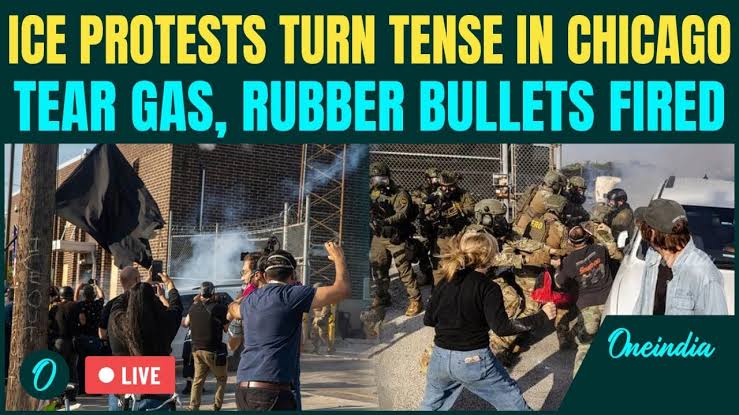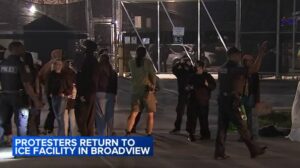Operation Midway Blitz: Illinois Protests Turn Tense

Caos on Friday brought the protesters and ice guards to the suburban broadview to fight outside a federal immigration facility. Today we will discuss about Operation Midway Blitz: Illinois Protests Turn Tense
Operation Midway Blitz: Illinois Protests Turn Tense
In early September 2025, the Trump administration, through the Department of Homeland Security (DHS), initiated Operation Midway Blitz in Chicago and statewide Illinois. The primary objective was to ramp up immigration enforcement—especially targeting undocumented immigrants with criminal convictions. What began as a policy-driven operation has evolved rapidly into a lightning rod for protests, legal challenges, and fierce political debate.
By September 19, nearly 550 arrests had been made in the Chicago area under this operation. Officials assert that about half of those arrested are subject to targeted enforcement (for criminal history or final removal orders), while the rest were encountered incidentally.
Roots & Purpose

The official justification from DHS and ICE states that Operation Midway Blitz aims to enforce federal immigration law, particularly against non-citizens considered dangerous due to prior convictions. The operation also responds to criticism that sanctuary policies in Illinois and Chicago hinder federal law enforcement.
The “Midway” reference is symbolic—evoking Chicago’s Midway Airport and also the Battle of Midway—connoting a decisive confrontation in the realm of immigration enforcement. Some commentary sees the name as intentionally militaristic.
Key Incidents
Several high-profile clashes and troubling incidents have magnified concerns:
-
Fatal Shooting in Franklin Park: Silverio Villegas-Gonzalez, a Mexican national, was shot and killed by an ICE agent during an arrest attempt. DHS reports he allegedly dragged an ICE officer with his car. The incident sparked outrage and calls for accountability.
-
Protests at Broadview ICE Facility: Demonstrators, including local politicians and community activists, gathered outside the ICE processing center. Encounters with federal agents turned violent in some instances: tear gas and pepper balls were used, protesters were pushed, photographs were taken, and arrests followed. Notably, Evanston Mayor and congressional candidate Daniel Biss was injured by chemical agents, describing serious breathing issues. Kat Abughazaleh, another Democratic candidate for Illinois’ 9th District, was thrown to the ground during one such protest.
-
Community Response and Fear: Immigrant communities in Chicago and suburbs report elevated anxiety. Many feel unsafe going about daily life, attending cultural events, or using public spaces due to fear of ICE presence. In some neighborhoods, events were modified or relocated out of safety concerns.
Political & Legal Backlash
The operation has met strong pushback from Illinois state leadership, community groups, legal experts, and immigrant rights advocates.
-
Governor vs. Federal Government: Illinois Governor J. B. Pritzker has condemned Operation Midway Blitz, calling it a federal overreach and criticizing the lack of coordination. He has signaled possible legal challenges.
-
Sanctuary Policy Debate: Chicago and state sanctuary policies—which limit cooperation between local law enforcement and ICE—are central to the controversy. Federal officials claim those policies hinder detention and removal of non‐citizens with criminal records. Opponents argue that sanctuary policies protect community safety by encouraging undocumented persons to report crimes without fear.
-
Civil Rights, Due Process, and Excessive Force: Many protestors, legal analysts, and city officials accuse ICE and affiliated agents of using excessive force and violating civil rights. Points of contention include:
-
The use of tear gas, pepper balls, and other chemical agents in crowd control.
-
Allegations of lack of body cameras or video transparency.
-
Incidents where U.S. citizens or people without criminal histories were allegedly detained or harmed.
-
Community & Activist Response
Activists, community organizations, immigrant rights groups, and local leaders have mobilized in response.
-
Protests & Demonstrations: Regular demonstrations at ICE facilities, especially in Broadview, have drawn hundreds of people. These protests often begin peacefully but escalate when enforcement vehicles enter or leave the facilities.
-
Know-Your-Rights Campaigns: Organizations have been distributing information in multiple languages (English, Spanish) to inform residents about their legal rights when confronted by immigration agents. Collaborations between faith groups, immigrant rights coalitions, and legal aid societies have increased.
-
Cultural Resistance: Some cultural events and celebrations have been altered to avoid exposure to ICE enforcement. Parades, festivals, and large community gatherings in Latino neighborhoods have either been relocated or modified for safety.
-
Political Engagement: Local elected officials—mayors, congressional candidates—are directly involved, both in protests and in public calls for oversight. For example, Daniel Biss and Kat Abughazaleh have drawn attention by being present in protests and reporting mistreatment.
Effects & Impacts
The consequences of the operation and the resulting protests are extensive and multifaceted.
Social & Psychological
-
Fear and Self-Censorship: Immigrant families (especially mixed status) report fear of using public transport, going to work, sending children to school, or attending public events. Some are staying home.
-
Community Distrust: Trust between immigrant communities and both local and federal institutions has eroded. There is concern that witnessing force, seeing unmarked vans, and uncertain legal outcomes compound existing mistrust.
Legal & Constitutional Issues
-
Due Process Questions: Critics point out the lack of transparency in detainee treatment, the criteria for arrests, and possible detentions of U.S. citizens. Legal scholars are scrutinizing whether ICE is respecting constitutional protections.
-
Oversight & Accountability: Governors, state attorneys, and local governments are demanding detailed reports, body cam footage (if available), and open investigations into incidents like the Franklin Park shooting.
Political Consequences
-
Polarization: The operation deepens divisions—between the federal government and sanctuary jurisdictions, between those prioritizing immigration control and those emphasizing civil liberties.
-
Electoral Implications: Candidates participating in protests, or who have been directly affected, may gain visibility in upcoming elections. Meanwhile, criticism from immigrant communities could influence voter turnout and public sentiment.
Legal & Policy Outcomes
-
Potential Litigation: Governor Pritzker and other state leaders are exploring legal challenges. There may be court cases on jurisdictional authority, constitutional rights, and whether local policies were violated by federal actions.
-
Policy Adjustments: The wave of protests and political pressure could lead to modifications in how ICE operates—e.g., clearer rules for use of force, communication channels with local governments, more stringent oversight. Whether these will materialize remains uncertain.
Key Questions & Criticisms
Several criticisms are central to the debate over whether Operation Midway Blitz is justified or lawful, and whether its costs outweigh its gains.
-
Who is Getting Arrested?
While ICE says many arrests are of individuals with criminal records or final deportation orders, there are concerns about collateral detentions—that is, people without serious offenses or even U.S. citizens being caught up due to mistaken identity or aggressive tactics. -
Use of Force & Search Methods
Tear gas, pepper spray, and other “less-lethal” but still harmful methods are under scrutiny. Are they proportionate? Are they exercised with proper warnings? Are agents identifiable and following procedural norms (body cams etc.)? -
Notification & Coordination with Local Authorities
Some local officials say they were given little to no notice. Illinois Governor has criticized DHS for lack of communication. This raises questions about federalism and cooperative governance in immigration enforcement. -
Sanctuary Policies vs. Public Safety
There’s an ideological clash: proponents of the operation argue sanctuary policies embolden criminals and hinder public safety. Opponents counter that sanctuary policies preserve trust with immigrant communities, improving public safety by encouraging victims of crime to report without fear of deportation. The balance is tricky. -
Transparency & Accountability
The demand for evidence, for independent oversight, for accounting of detainee treatment and outcomes is high. How will the federal agencies manage this? Will incidents like the Franklin Park shooting be fully and fairly investigated?
What Comes Next?
Looking ahead, several scenarios are likely, depending on how different actors respond.
-
Escalation or De-escalation: If protests continue aggressively and legal challenges intensify, there may be pressure on DHS/ICE to modify tactics or slow down the pace. Alternatively, the federal government may double down, pushing for broader operations or deploying additional resources.
-
Legal Rulings: Court cases may define limits of federal power, especially in states with sanctuary policies. Rulings could force changes in how ICE notifies local governments, uses force, or detains people.
-
Impact on Immigrant Communities: The psychological, social, and economic impacts are likely to deepen. Fear could influence migration patterns, willingness to interact with public services, or participation in community life. Support structures (legal aid, advocacy groups) will be critical.
-
Political Fallout: With candidates being directly involved, this issue will likely be front-and-center in upcoming elections in Illinois and nationally. Who is seen as defending civil liberties vs. who is seen as tough on immigration will be a key division.
-
National Implications: If Illinois or Chicago’s experience shapes public opinion or legal precedents, it could serve as a template or warning for other states facing similar federal enforcement operations.
Conclusion
Operation Midway Blitz is shaping up to be more than just an immigration enforcement campaign—it is rapidly becoming a test case for many of the tensions at the heart of U.S. immigration policy: enforcement vs rights, federal authority vs state/local resistance, and public safety vs civil liberties.
For immigrant communities, this operation has brought fear, disruption, and a sense that everyday life is under surveillance. For local leaders, it has become a question of defending constitutional norms and local autonomy. For the federal government, it is a demonstration of resolve but also a source of political risk.
As protests intensify, legal challenges grow, and media coverage continues, one thing is clear: Operation Midway Blitz will leave a lasting mark on how America manages immigration enforcement in the 21st century. The outcome will hinge not just on arrests or headlines—but on transparency, justice, and the ability of communities to demand accountability.
How useful was this post?
Click on a star to rate it!
Average rating 0 / 5. Vote count: 0
No votes so far! Be the first to rate this post.
About the Author
usa5911.com
Administrator
Hi, I’m Gurdeep Singh, a professional content writer from India with over 3 years of experience in the field. I specialize in covering U.S. politics, delivering timely and engaging content tailored specifically for an American audience. Along with my dedicated team, we track and report on all the latest political trends, news, and in-depth analysis shaping the United States today. Our goal is to provide clear, factual, and compelling content that keeps readers informed and engaged with the ever-changing political landscape.




